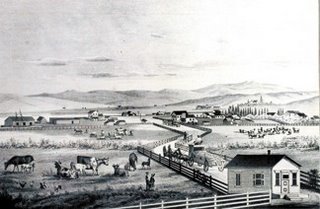By Barry Eberling

Denverton life is shown in the Historical Atlas of Solano County by Thompson and West, 1877. (Courtesy Illustration)
FAIRFIELD - David Lundquist has tried to find Solano County towns so far gone that not even a ghost haunts them.
Denverton, Binghamton, Maine Prairie and Silveyville are local towns that are missing in action. Lundquist once flew over the county in a plane looking for some trace - anything - of these historic places.
"I was hoping to see an outline of something," Lundquist said. "There was nothing, for the most part. I don't think they were there long enough to leave a lasting mark."
Establishing towns in pioneer Solano County was a Darwinian proposition. Only the strong - and, in some cases, the lucky - survived.
Lundquist, who retired three years ago as a University of California, Davis, librarian, has been interested in old towns for three decades. He helped care for the university's vast collection of old maps for 30 years, so he had the resources at his fingertips to do research.
In the mid-1970s, Lundquist saw an irrigation district map that showed the town of Yolano in remote northeast Solano County, along the old Sacramento Northern tracks. He'd never heard of Yolano.
One rainy day, he drove out to the supposed pioneer-era townsite. He found only the old Sacramento Northern tracks, which have since been torn out. Somebody had wanted to found a town there because the trains provided a good way to haul crops to market, but never got farther than putting lines on a map.
Lundquist noted the state highway had gone in during the early 1900s several miles from the proposed town of Yolano. No longer did farmers have to depend on the strict schedule of a railroad. They found it easier to haul goods by truck.
Caught in the transition from trains to auto, Yolano died while a mere idea. But the dead town gave birth to a new hobby for Lundquist. He spent future years tracking down the region's lost towns.
Lundquist looked at places that had once bustled with activity, where the sounds of the blacksmith hammers rang and horses pulled wagons loaded with grain. Maine Prairie, Denverton, Binghamton - they had each done a disappearing trick.
"There's nothing there," Lundquist said. "That's the thing that struck me. Some of these towns were good size for their time, there were a few hundred people there."
Ask Lundquist why these Solano County towns either faded or dropped off the map and he has the same answer: "Transportation." Just as in the case with Yolano, transportation proved key.
He's not the first one to come to that conclusion. Back in July 1869, the Solano Republic newspaper pondered the fate of Maine Prairie. With the railroad, farmers no longer had to bring grain to this shipping point on Cache Slough.
"It is now dead," the paper concluded. "The railroad has killed it. The businesses of the place are watching the corpse."
Transportation is the lifeblood of towns, bringing citizens and providing ways to move goods. Pioneer towns that thrived when schooners and steamships were king withered when the railroad passed them by.
Next, some of these rail towns in turn withered when the state highways and freeways rose to transportation ascendancy.
So Fairfield, Suisun City, Dixon, Benicia, Vacaville, Vallejo and Rio Vista shouldn't be too smug that they thrived and other towns faded or died. Had the rail lines and state highway taken a different route, the map of modern Solano County might look far different indeed.
Then perhaps the Binghamtons and Denvertons would be among today's population centers. Then perhaps "lost town" hunters such as Lundquist would be researching the story of Fairfield.
Reach Barry Eberling at 425-4646 Ext. 232. or at beberling@dailyrepublic.net.
